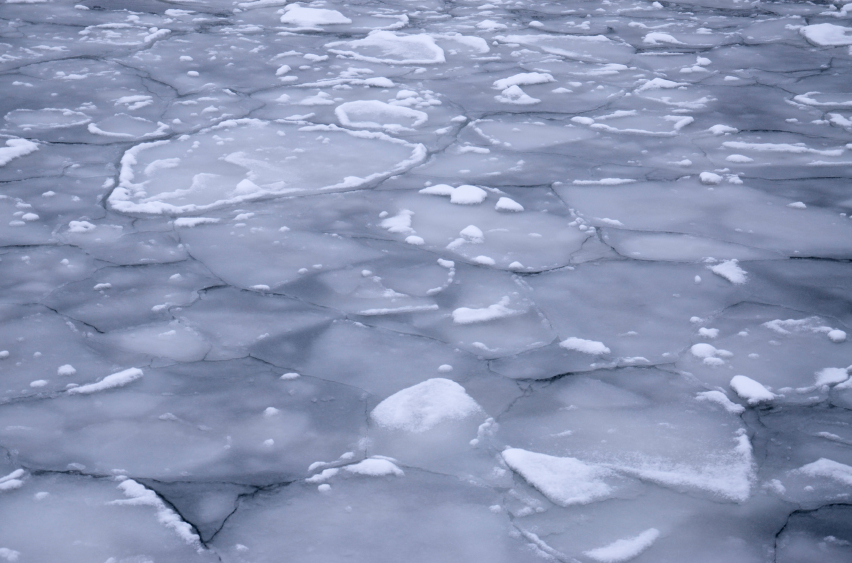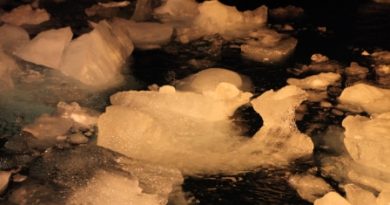Annual Arctic Report Card details continued warming on land and sea

While the Arctic in 2014 continued its long-term warming, much of the rest of the world was struck by wacky and extreme weather, and studies are underway to determine whether the trends are related, said scientists who released an annual report on the Arctic on Wednesday.
The Arctic Report Card 2014, compiled by the U.S. National Oceanic and Atmospheric Administration, described a year of warm weather, open seas, proliferating far-north plankton blooms and steady spread of vegetation northward.
Overall warming continued in the Arctic in 2014 at twice the global rate, but there were areas of noteworthy weather, said the report card. January temperatures in Alaska soared as much as 18 degrees higher than average, for example, and the story was similar in northern Europe, the report said. Sea surface temperatures in the Chukchi Sea, Bering Strait region and the Laptev Sea north of Russia were particularly high, up to 7.2 degrees above the 1982-2010 average, the report said.
Related to — and reinforcing — the warmer Arctic conditions was continued diminishment of sea ice and terrestrial snow cover, said the report, released at the American Geophysical Union annual meeting in San Francisco.
Sea ice retreat
Sea ice retreated this year to the sixth lowest coverage on satellite record. The dearth of snow cover was more dramatic, according to the report. April snow cover in Eurasia was the lowest on record, and June snow cover in North America was the third lowest on record. Snow disappeared three to four weeks earlier than normal across much of the far north, thanks to lower snowpack amounts and high temperatures.
While the Arctic basked in warmth and early thaw, a wavy jet stream pattern pushed bitter cold to the U.S. East Coast and other mid-latitude areas, report authors said.
That lead scientists to ask: Are events in the Arctic and the mid-latitudes related?
There is not yet a consensus about that, said NOAA oceanographer Jim Overland, who cited the short duration of the period in which the phenomenon was documented and the “normal chaos” of weather.
“We know that the Arctic temperatures are greatly increasing, so the forcing is there but the linkage is still circumstantial,” Overland said at a news teleconference unveiling the Arctic Report Card. “We’ve seen a more wavier jet stream in the last five winters compared (to) before that, so the potential is there, but the (scientific) community is still uncertain whether that’s primarily random or the sea ice or snow, or other factors, may be persisting.”
Role of jet stream
Steve Vavrus, senior scientist at the University of Wisconsin’s Center for Climatic Research, agreed that the “jury is still out” on the relationship between the jet stream meandering and the warming Arctic, but that recent experience is an important lesson.
“These wavy, highly wavy, high persistent weather patterns can have a huge impact, regardless of the cause, and if, in fact, they are going to become more common as a result of Arctic amplification, this is something that we really need to resolve and get beyond whose method is correct and how to assess the data at this point,” Vavrus said at the news conference.
Other elements of the Arctic Report Card discussed the status of the world’s polar bear subpopulations, some of which are in decline. The Southern Beaufort Sea and Western Hudson Bay populations are among the four populations known to be in decline, while Canada’s McClintock Channel population is the only one known to be increasing, according to the report card.
Predictions for an ice-free Arctic
Conditions in Greenland, where reflectivity of the ice sheet in August was the lowest ever measured, were also discussed in the report. Although melting occurred over nearly 40 percent of the ice sheet, and although the rate was above the average measured from 1981 to 2010, the total mass of the ice sheet was unchanged at the end of the melt season, the report said.
Asked about predictions for an ice-free Arctic in summer, the report card’s chief editor noted that models vary — with some predicting such an event as soon as five or 10 years and others predicting ice-free conditions at the end of the century.
“The important point about the models is not to dwell on the fact that they differ, but it’s to dwell on the similarity, that they all point in the same direction towards, if not a totally ice-free summer/end-of-summer, a greatly, greatly reduced ice cover compared to what it is now,” said Martin Jeffries, Arctic science adviser and program officer for Arctic and Global Prediction at the Office of Naval Research.
It is also important to recognize that Arctic sea ice need not completely disappear in summer for the melt to have major impacts on physical and biological systems or human uses, Jeffries said.
“You don’t have to go to zero for these to become a big deal,” he said.
Related stories from around the North:
Canada: How climate is changing the Arctic – The `Big Picture,` Deutsche Welle Iceblogger.
Greenland: Field notes from Greenland – From the glacier to the sea, Blog by Mia Bennett
Russia: Arctic methane: time bomb or “boogeyman”?, Analysis from Deutsche Welle’s Iceblogger
Sweden: Sweden’s environment minister positive on Lima deal, Eye on the Arctic
United States: NASA findings show no excessive methane emissions from Alaska, Alaska Dispatch



